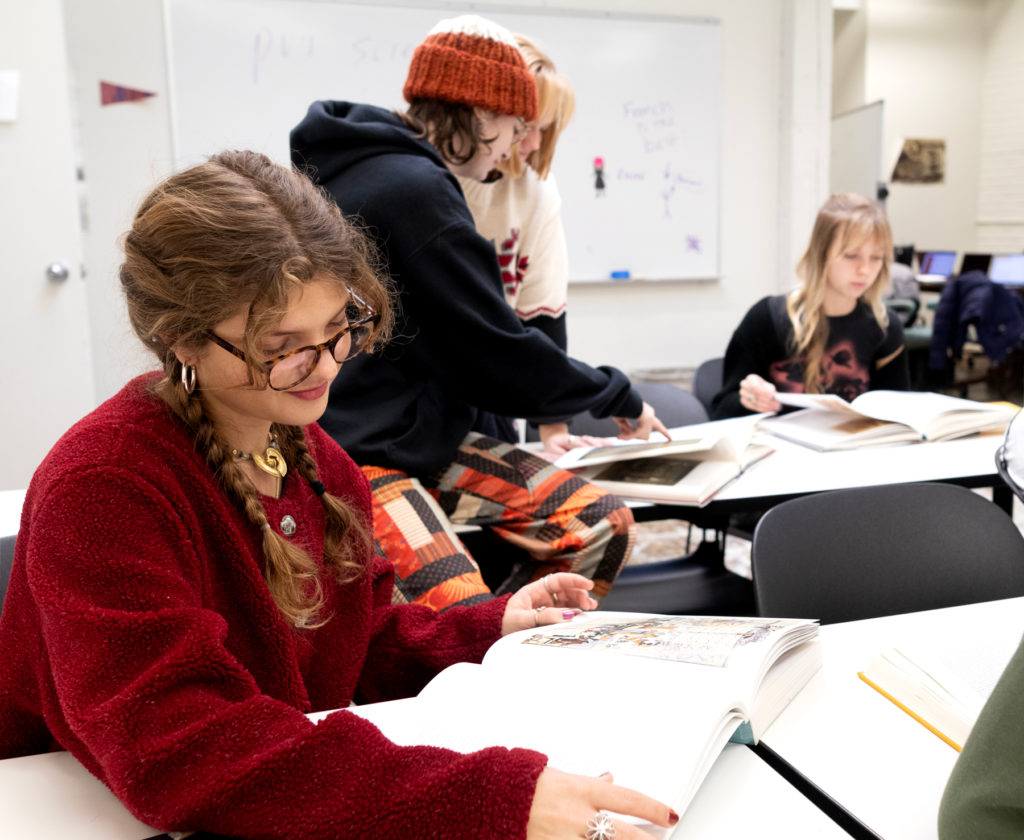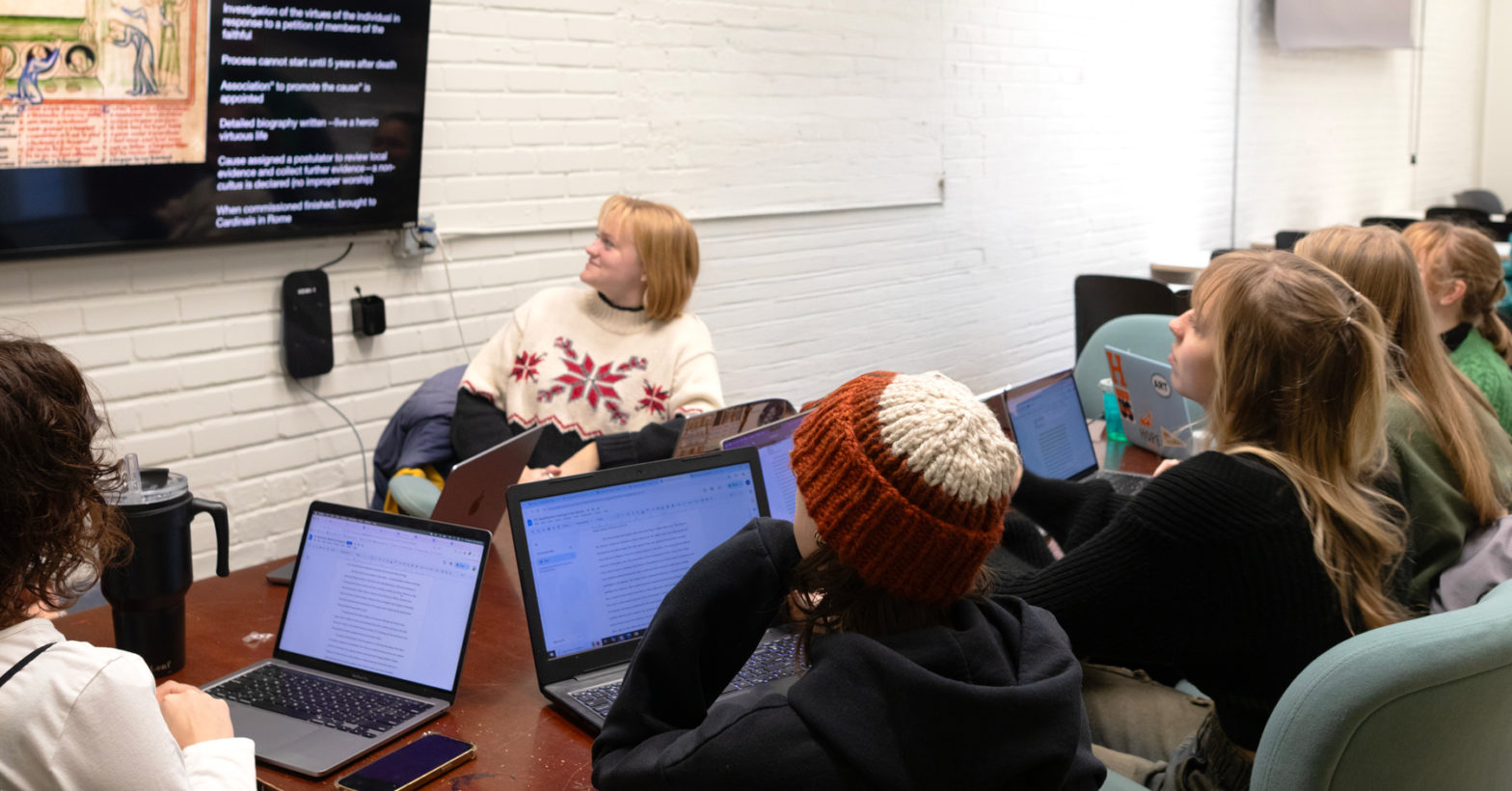Original research conducted by Hope students is at the heart of the exhibition “Saints and Syncretism in Global Christian Art” (Jan. 14–May 17, 2025), a display of works from the college’s Permanent Art Collection celebrating the 10th anniversary year of the college’s Kruizenga Art Museum.

There are sound pedagogical reasons for that, with students learning skills that will serve them well whatever their career path. It’s a proven approach to teaching via hands-on application that the college emphasizes campuswide — and for which Hope has repeatedly been nationally acclaimed for decades.
But there’s also this: Discovering the undiscovered is amazing.
“You were finding things that you never expected to, and finding things that people before you didn’t know,” said junior Shannon Smith, who was one of the nine students who spent the fall semester tracking down the background for the descriptions of the pieces in the show while enrolled in the Art 361 course Special Projects in Art History taught by Dr. Anne Heath.
There are sound pedagogical reasons that Hope provides opportunities for students to conduct original research mentored by faculty, but there’s also this: Discovering the undiscovered is amazing.
“You were finding things that you never expected to, and finding things that people before you didn’t know.”
—Hope junior Shannon Smith
Helping prepare “Saints and Syncretism” also included the heady experience of studying the works up-close instead of only viewing them in a book or on a computer screen, and in the process sharing a connection with the person who had created or first held them, in some cases half a world and half a millennium away.
“We got to actually go and see all our pieces in person, in addition to doing the research,” said junior Gracie Allen.
Hundreds of Hope students participate in mentored research each year, some in teams led by a faculty member; some on independent projects; others through courses like Art 361. The practice at Hope — which has been emulated for undergraduates by many other institutions because it’s so effective as an instructional model — is widely understood to have begun in its modern sense through the work of the late Dr. Gerrit Van Zyl, a member of the chemistry faculty from 1923 to 1964, but has long since expanded to every department including, as shown through this story, the Department of Art and Art History. Given that history and impact, it’s been a priority at the Kruizenga Art Museum since the beginning.
“The Kruizenga Art Museum’s primary mission is to support the teaching curriculum of Hope College, including undergraduate research,” said Charles Mason, who is the director and the Margaret Feldmann Kruizenga Curator of the Kruizenga Art Museum.
“Thanks to an endowment created by Class of 1964 alum John H. Dryfhout, the museum has funds to pay student interns to assist us in planning and implementing our exhibitions,” Mason said. “Students have created content and helped design the installations for many KAM exhibitions over the years, starting with our very first exhibition in 2015.”
“Saints and Syncretism” is the third time that the Kruizenga Art Museum has worked with student curators under the supervision of Heath. The museum also worked with her students on a print exhibition in 2018 and a Yoruba art exhibition in 2020.
In addition, Mason worked with student curators for the museum’s inaugural exhibition in 2015, a Meiji Japanese art exhibition in 2017, an Ethiopian Christian art exhibition in 2018, and a portraiture exhibition in 2022.
“Students have created content and helped design the installations for many KAM exhibitions over the years, starting with our very first exhibition in 2015.”
—Charles Mason, who is the director and the Margaret Feldmann Kruizenga Curator of the Kruizenga Art Museum.
“For all of those exhibitions, the students did original research on the artworks and wrote the interpretive labels for the exhibitions,” he said. “We also do student-curated exhibitions where the students choose artworks that are personally relevant to them and write labels that reflect their own responses or reactions to the artworks.”
The Kruizenga Art Museum, which opened on Sept. 9, 2015, is named in honor of a leadership gift from the late Dr. Richard and Margaret Kruizenga of Holland, both of whom graduated from Hope in 1952. The museum features two public galleries as well as a study room and climate-controlled storage space for the college’s 7,000-object permanent collection.
“One of the main reasons we’ve focused on building up a large permanent art collection — rather than, say, bringing in lots of borrowed artworks — is to create a lasting resource that students and faculty can research and write about many times over the years,” Mason said. “As they uncover new facts or come up with new insights and interpretations, we add that information to the museum’s collection database so that it is preserved and can be shared with the rest of the Hope College community and the broader public through the museum’s website.”
Two of the students in Art 361— junior Lauren Carpenter and senior Mimi Tiews — worked at the Kruizenga Art Museum as curatorial interns during the summer of 2024 and developed the general topic, and along with Heath, Mason and the rest of the museum’s staff reviewed the collection to select works for it and even identify additional works for accession. Carpenter and Tiews then continued with the project via the class; the nine students shared responsibility for researching the 50-some pieces that are in the exhibition, a mix that spans the 15th through 21st centuries, and includes work from Africa, Asia, Europe, North America and South America.
Developed through original research by the students of Art 361 this past summer and fall, the exhibition “Saints and Syncretism in Global Christian Art” is running Jan. 14 – May 17, to open the Kruizenga Art Museum’s 10th anniversary year. The Kruizenga Art Museum is located at 271 Columbia Ave., between 10th and 13th streets. Public visiting hours are Tuesdays through Saturdays from 10 a.m. to 4 p.m. Admission to the museum is always free. Please visit the college’s news release for more about the exhibition itself.
The nine students included, as one might expect, art history and studio art majors, but there was no such requirement — the group’s academic majors also included communication, elementary education, English and German, and minors such as chemistry. They worked individually, learning about multiple individual saints from across two millennia, and reflecting on items ranging from a 15th century book from Europe, to an image of the Virgin Mary from China, to Yoruba beadwork Nigeria, to paintings from Ethiopia, to a World War I propaganda poster depicting Joan of Arc, considering not only symbolism but the materials and cultural context. They learned collectively, reporting to the group the results of their research, and together zeroing in on the title and specific approach that best fit: “Saints and Syncretism in Global Christian Art,” exploring how faith and cultural traditions influence one another. They developed the catalog entries for each piece, wrote the descriptions for the informational placards on the walls, determined the gallery layout and even planned the opening reception.
“The students had a variety of media, times and geographic locations to consider, in addition to their readings about the saints, and put it all together in a logical way,” Heath said. “Because it’s an art history class, they also emphasized the objects themselves — the techniques, the materials, the art history around them,” she said. “They put the art objects front and center and listened to what they had to say. Art works can tell quite a story.”


